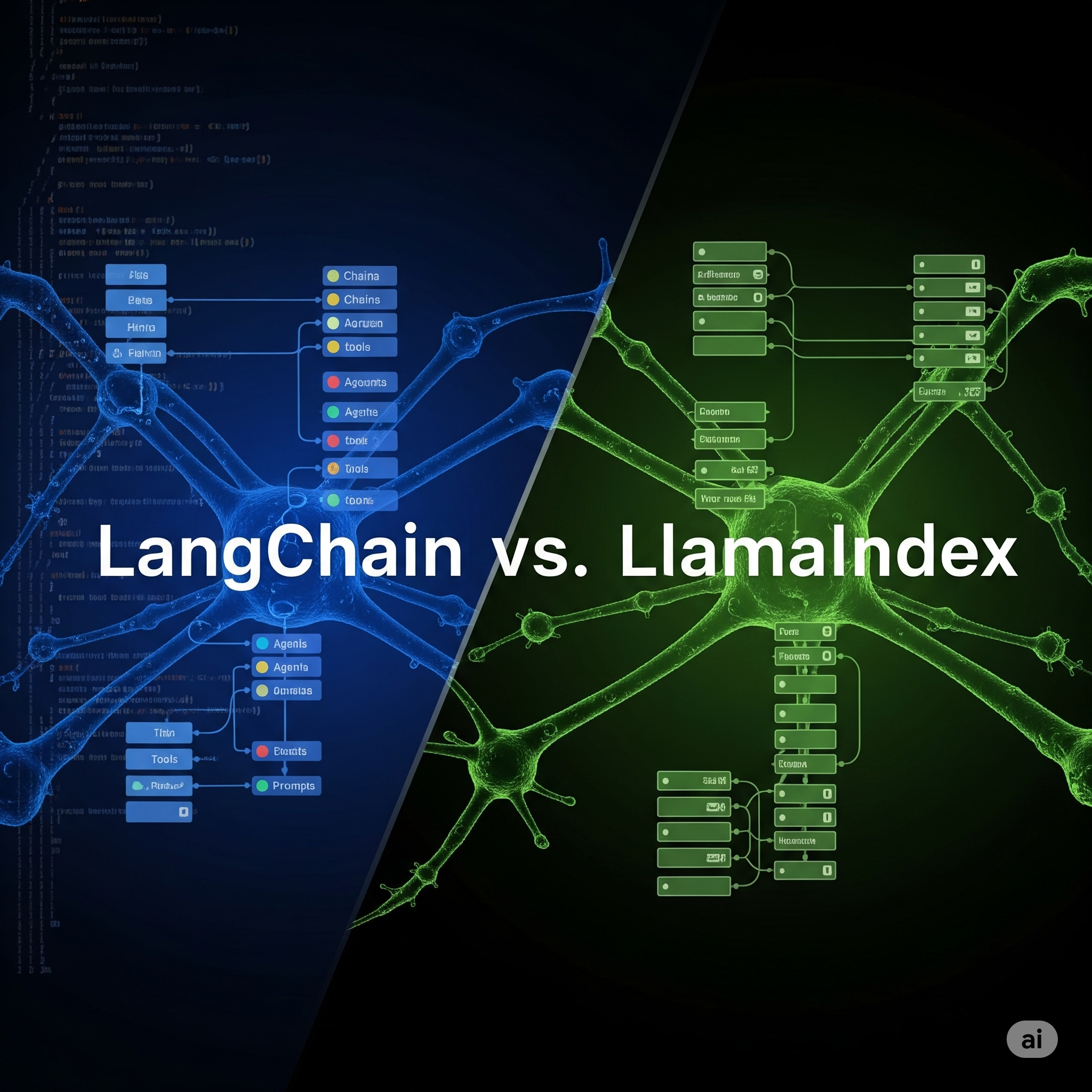Retrieval-Augmented Generation (RAG) is transforming how AI delivers accurate, context-rich answers by combining large language models with real-time data retrieval. Two leading tools in this space—LangChain and LlamaIndex—take very different approaches to achieving the same goal: smarter, more reliable AI outputs.
In this blog, we’ll break down their strengths, differences, and best use cases, helping you decide which RAG framework is the perfect fit for your next AI project.

Table of Contents
Two of the most popular tools in this space are LangChain and LlamaIndex. While both serve a similar goal making LLMs smarter through external knowledge they have distinct strengths, features, and ideal use cases. If you’re deciding between the two, this guide will help you make the right choice.
1. Understanding RAG and Why It Matters
Large language models like GPT-4 are powerful, but they have a fundamental limitation: they don’t have built-in access to your private or real-time data. RAG solves this problem by:
- Retrieving relevant documents from a knowledge base.
- Feeding that context into the LLM prompt.
- Generating more accurate and grounded answers.
Both LangChain and LlamaIndex aim to streamline this process, but they approach it differently.
2. What is LangChain?
It is a modular framework for building applications with LLMs. While it supports RAG, it’s much more than that it provides tools for:
- Prompt engineering and chaining multiple LLM calls.
- Integrations with vector databases like Pinecone, Weaviate, and Chroma.
- Agent-based workflows where the AI can decide which tools to use.
- Customizable pipelines for building chatbots, summarizers, and more.
Best For: Developers who want a general-purpose LLM application framework that can handle RAG plus other AI-powered workflows.
3. What is LlamaIndex?
It is laser-focused on data indexing and retrieval for LLMs. Its primary strength lies in making it easy to:
- Ingest large volumes of unstructured and structured data.
- Build retrieval pipelines optimized for your data source.
- Integrate with existing LLMs for accurate, context-rich outputs.
It comes with smart indexing techniques from simple vector indexes to advanced hierarchical indexes allowing more efficient querying.
Best For: Teams that need a dedicated RAG pipeline with optimized retrieval performance and minimal overhead.
4. Key Differences Between LangChain and LlamaIndex
| Feature | LangChain | LlamaIndex |
|---|---|---|
| Primary Focus | General LLM application framework | RAG-focused indexing and retrieval |
| Ease of Setup | More complex (due to broad scope) | Faster for RAG-only use cases |
| Integrations | Many external APIs, vector DBs, tools | Primarily data sources and storage |
| Flexibility | High—build any LLM app | Moderate—optimized for retrieval tasks |
| Learning Curve | Steeper | Easier for RAG beginners |
5. When to Choose LangChain
Pick LangChain if you:
- Want to build complex AI workflows beyond RAG.
- Need agent capabilities where the AI decides which actions to take.
- Plan to integrate multiple tools and APIs in your application.
Example use case: An AI customer support bot that pulls data from a knowledge base, makes API calls, and formats a report all in one workflow.
6. When to Choose LlamaIndex
Pick LlamaIndex if you:
- Need fast and reliable RAG without extra features.
- Want to index large datasets for quick retrieval.
- Prefer minimal setup to get results quickly.
Example use case: A research assistant that scans thousands of PDFs, retrieves relevant excerpts, and feeds them into an LLM for precise summaries.
7. Can You Use Both Together?
Yes and many teams do. A common approach is to use LlamaIndex for optimized data ingestion and retrieval, then plug it into LangChain for more complex workflows. This hybrid setup combines the best of both worlds: efficient indexing plus flexible application building.
Conclusion
- Choose LangChain for flexibility, multi-step workflows, and diverse integrations.
- Choose LlamaIndex for specialized, fast, and efficient retrieval pipelines.
- Use both if you want a complete RAG + workflow automation powerhouse.
Ultimately, the “right” choice depends on your project’s scope. For many developers, starting with LlamaIndex for quick wins and later adding LangChain for more complexity works best.
Related Reads
- 20+ Mind-Blowing LLM Apps You Can Build Today – From AI Agents to RAG Pipeline
- Top10 Beginner-Friendly LLM Projects to Kickstart Your AI Journey
- LLM Agents: What They Are, How They Work, and Why They’re the Future of Autonomous AI
- 10 Free GitHub Repositories to Build a Career in AI Engineering
- Evaluating Large Language Models: Metrics, Best Practices and Challenges
External Resources
LangChain Documentation – https://docs.langchain.com
LangChain GitHub – https://github.com/langchain-ai/langchain
LlamaIndex Documentation – https://docs.llamaindex.ai
LlamaIndex GitHub – https://github.com/run-llama/llama_index


5 thoughts on “LangChain vs LlamaIndex: Powerful Retrieval-Augmented Generation Tools Compared”